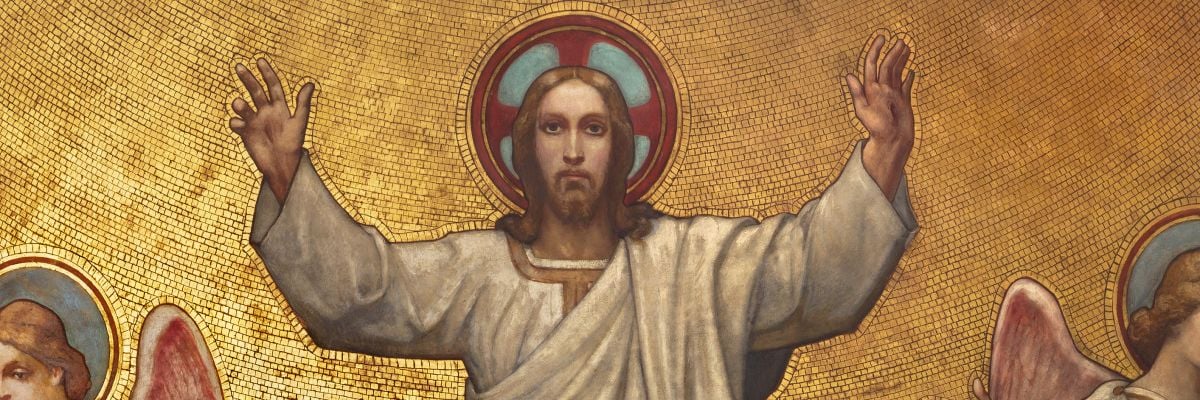
At the climax of the forty days spent with the disciples after his resurrection, Jesus ascended bodily into heaven. Catholics have always understood this to be a literal, miraculous event. We believe it really happened—and as a Church we profess it every Sunday.
But the dogma also has its detractors. Some have made a mockery of the doctrine, likening the “flying” Jesus to an Apollo spacecraft, as was a common jest among atheists in the 60s and 70s. Others deny the possibility of the miraculous altogether. Still others, like Episcopalian theologian John Shelby Spong, read the ascension as non-literal and symbolic: “A modern person knows that if you rise up off the Earth (as in the ascension), you don’t go to heaven. You go into orbit.”
Considering such criticisms, how can Catholics defend the reality of Christ’s ascension?
One might sympathize with Spong’s objection above. After all, isn’t heaven supposed to be “beyond” the physical universe? It’s an interesting objection, one to which C.S. Lewis offered what I find to be a satisfying rebuttal. After his Resurrection, it may have been that Our Lord,
a being still in some mode, though not our mode, corporeal, withdrew at His own will from the Nature presented by our three dimensions and five senses, not necessarily into the non-sensuous and undimensioned but possibly into, or through, a world or worlds of super-sense and super-space. And He might choose to do it gradually. Who on earth knows what the spectators might see? If they say they saw a momentary movement along the vertical plane – then an indistinct mass – then nothing – who is to pronounce this improbable?
So it may have been that Jesus, still in bodily form, chose to ascend not to the stars, but simply from the ground as the beginning of the super-physical journey to heaven. This still assumes, of course, that miracles are possible. But are they?
Miracles are by definition supernatural events; and science only examines natural phenomena. To make a definitive claim about whether miracles can occur, one must look beyond, for example, microscopes and rulers and ask if such events are possible on philosophical grounds. Perhaps you have heard some version of David Hume’s objection that a miracle is a violation of the laws of nature. The assumption is that God, if he existed, would have no right to create a supernatural effect in the natural world. But why not? The believer’s claim has consistently been that God is the First Cause of all physical reality. This means he is the creator and sustainer of the natural laws and the things they govern. He is the supreme Lawmaker.
It is absurd to charge him, then, with breaking his own “laws” since he is under no moral nor logical obligation to cause effects only via the normal physical causal relationships he himself upholds. As philosopher Alvin Plantinga has asked, why can’t we think of the laws of nature as descriptors of how God usually treats the matter he has created? And as we find that so many established theories end up being inadequate to explain all relevant phenomena, how can we say we even know with complete certainty what “the laws” are?
Another step in fortifying our defense of Christ’s ascension is to show that there are good reasons to believe in Jesus’ resurrection. If the possibility of Jesus’ resurrection may be rationally entertained, then so may be his ascension.
One of the most effective ways to make the case for the Resurrection is to use the minimal facts approach proposed originally by scholar Jürgen Habermas. This involves considering the historical facts accepted widely by all experts (most skeptics included), then demonstrating that the resurrection, rather than a natural explanation, is the best explanation for them. Such well-evidenced facts—what historian Mike Licona calls “historical bedrock”—include Jesus’ death by crucifixion, the reported appearances of the risen Christ, the empty tomb, and the sudden conversion of St. Paul, enemy and persecutor of the first Christians.
Another theory is that the disciples were hallucinating when they saw the resurrected Jesus. This hypothesis is plagued from the start by the fact that entire groups claimed to see Jesus at one time (1 Cor. 15:3-6). Group hallucinations are unlikely since people share neither brains nor minds. But even if mass hallucinations did occur, what could explain St. Paul’s conversion? What are the chances that he and Christ’s followers would hallucinate the same risen Jesus? The most tenable explanations for all these events involve a real person, Jesus, risen from the dead after his Crucifixion.
Could the account of the ascension itself be questionable? With St. Luke is our primary source, how can we trust that he is telling us history and not an allegory? John Shelby Spong finds this explanation most likely: “Luke never intended his writing to be understood literally. We have greatly misrepresented Luke’s genius by reading it literally.”
The problem with this reading is that Luke explicitly rejects its possibility. The evangelist clearly asserts in the prologue to his Gospel that his intention is to describe real history. Furthermore, when Luke describes the ascension there is no hint of embellishment, which is strange indeed if he did not intend it literally. In the gospel account he simply tells us that Jesus “parted from them and was carried up into heaven” (Luke 24:52). In Acts, he writes that Jesus “was lifted up, and a cloud took him out of their sight” (Acts 1:9). Cold and clinical, like a serious historian interested only in the facts, Luke just tells us what happened—and that’s it. It is also notable that because the Gospel accounts were written only a few decades after Jesus’ crucifixion, there would have been eyewitnesses of Jesus still alive to correct or object to Luke’s account. But there is simply no record of such an objection.
Indeed, Luke’s Gospel and his Acts of the Apostles (which are “companion volumes”) have been touted by scholars of ancient history and archaeology as impressively accurate. The great archaeologist Sir William Ramsay famously acknowledged St. Luke as “a historian of the first rank.” More recent studies of Luke’s historical accuracy, such as that by classical scholar Colin Hemer, have further confirmed the deservedness of this high praise. Thus, when Luke describes Jesus’ bodily ascension into the heavens, we have many good reasons to believe that St. Luke was reporting real history, “a narrative of the things which have been accomplished . . . just as they were delivered to us by those who from the beginning were eyewitnesses” (Luke 1:1).



